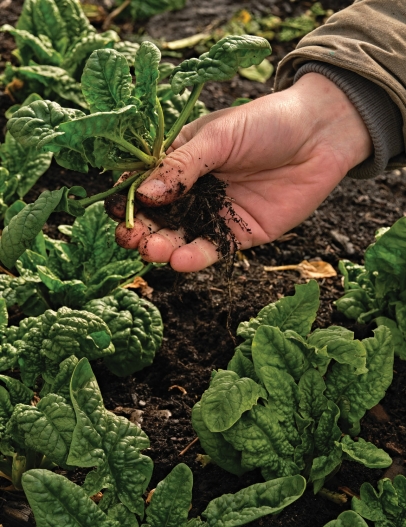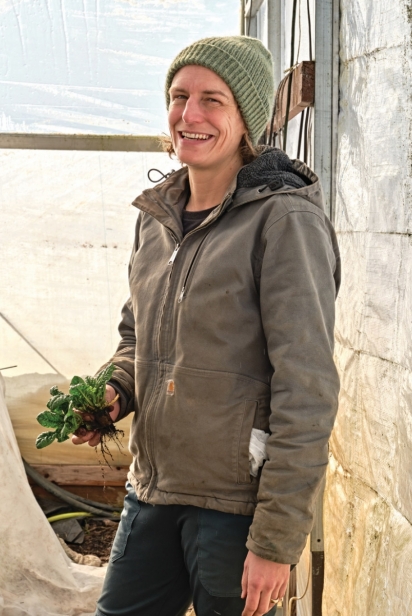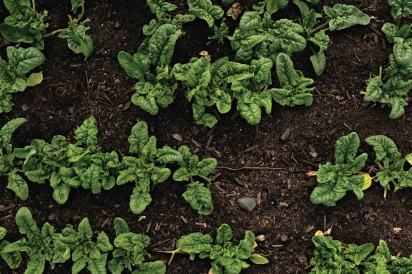The Sweet Side of Spinach
Nature’s Powerhouse Glorious Greens
THOUGHTS OF MICHIGAN in late winter and early springtimes don’t necessarily convey images of locally grown vegetables, but the warmer climate in recent years paired with the growing popularity of hoop houses has made Midwest winters ideal for producing what could be the country’s most flavorful spinach.
Like beets, Swiss chard and even quinoa, spinach is a member of the amaranth family. Its flexibility of form— fresh, frozen and canned—makes it readily available in many a pantry and refrigerator. While some may think solely of “baby spinach,” sweet leaves cultivated in their youth and often featured in mainstream salad mixes, Spinacia oleracea includes three major types:
• Smooth (flat leaf): With its spade-shaped leaves, traditionally used for both canning and freezing, baby spinach falls within this category, generally making this flat-leaf spinach the most popular in the United States. (Perhaps not coincidentally, it’s also the easiest to clean.)
• Savoy (curly leaf): Crinkly, curly leaves, typically dark green with pronounced veins that can make cleaning this variety a bit cumbersome, but savoy customarily delivers a heartier flavor compared to other varietals.
• Semi-savoy: As the name indicates, this type is similar to curly leaf, but less crinkly overall. Most semisavoy varieties have strong disease resistance, making them a top choice for both novice and professional growers.
When picked and packaged at its peak, spinach typically demonstrates sweet and tender leaves (though bitterness is likely to set in quickly after maturity). Coupled with a high water content (over 90 percent), this powerhouse green can be quite functional as a blank canvas for flavor. This culinary flexibility and brilliant color often make it a chef‘s favorite.
All this is to say nothing of the superfood status, boasted by all varieties of this nutrient-dense green. Known well as an excellent source of calcium and vitamins A, B and C, these powerful leaves are also packed with antioxidants, carotenoids and flavonoids, plus phytonutrients responsible for the vibrant colors in edible plants.
However, along with these nutritional benefits comes unwelcome oxalic acid, an organic substance that has been known to interfere with the absorption of nutrients like iron.
“You can easily increase iron absorption by eating spinach with vitamin C–rich foods like bell peppers, strawberries, or simply squeezing lemon juice over it,” according to Angela Wortley, a Washtenaw registered dietitian nutritionist.
Luckily, oxalic acid breaks down when heated, making both steaming and sautéing spinach appealing cooking methods. According to most nutrition researchers, consuming cooked spinach yields higher levels of vitamins A and E, protein, fiber, zinc, thiamin, calcium and iron. That said, raw spinach is still a valuable choice, providing more vitamin C, folate and potassium than its raw counterpart. Such a nutrition profile makes spinach a veritable win-win no matter the preparation.
Michigan’s colder months prove a suitable environment for most spinach crops, which don’t tolerate mid-summer heat well. Environmentalist Jill Lada and her husband, Nate, co-founded and manage Green Things Farm Collective on Ann Arbor’s north side. Both University of Michigan graduates, the couple runs the now-100-acre collective, which features five acres dedicated to veggies. The farm produces more than a ton of spinach annually, mostly the savoy type.
Jill Lada insists the sweetest spinach has been “kissed by frost.”
Spinach “grows really well in our climate in an unheated hoop house,” says Lada, explaining how cold-hardy crops like spinach are good as overwintered greens in a hoop house, where the goal is maintaining the temperature so it doesn’t get too hot too fast. “The hoop house stays about 10 degrees warmer at night [than outside].”
Another positive aspect of spinach is its relatively short growing time frame, requiring only about 45 days to maturity, according to Lada. This allows the farm to transition beds often, while employing no- or low-till techniques. Unsurprisingly, the Ladas and their team are forever tinkering to perfect their spinach crop; this includes consistently improving soil conditions, as well as experimenting with nutrient load, overall timing and seed depth.
So invested in the wonders of spinach is Green Things Farm Collective, it even sponsors a Spinach Club (aka salad club), where local customers can pick up one or two pounds of greens each week. Membership details for the club, as well as the farm’s CSA packages, are available on the collective’s website. The farm’s produce—including lettuce greens, onions, beets and potatoes—are also featured at local eateries Spencer and Jolly Pumpkin Ales + Kitchen in Ann Arbor and Dexter, respectively, as well as the Kerrytown Farmers Market and Argus Farm Stop.
Green Things Farm 3825 Nixon Rd., Ann Arbor greenthingsfarm.com
10 WAYS TO EAT MORE SPINACH
While spinach salad and warm artichoke dip may be staples for many, integrating this versatile veggie into even more dishes is effortless. Its subtle sweetness and creamy texture make spinach the perfect secret ingredient to boost the nutritional profile of any meal, anytime.
1 Sauté with liquid aminos and add to your favorite grain bowl or stir fry
2 Blend into a daily smoothie for a burst of green goodness
3 Mix into any pasta dish for a burst of color—and flavor
4 Add to your morning scramble, whether it be egg or tofu
5 Layer it on just about any sandwich or melt for a pop of freshness
6 Cream with pearl onions for a decadent side
7 Toss into your favorite soup or stew for wonderfully wilted added nutrients
8 Whip into mashed potatoes for an Irish-inspired colcannon
9 Sneak into any casserole recipe for stealth vitamins
10 Stir into guacamole
SPINACH’S EARLY POPEYE-LARITY
While most know Popeye’s super strength came from spinach, as popularized in the 1930s comic strip, few know this green veggie selection was actually a product of a typo. Spinach’s iron levels were erroneously reported in an 1870s researcher’s notes as 35 milligrams, instead of the actual 3.5 milligrams. Popeye’s creator chose spinach as a hero-bolstering superfood for this (inflated) iron load. Decades later, the lore of spinach’s superpower remains.







